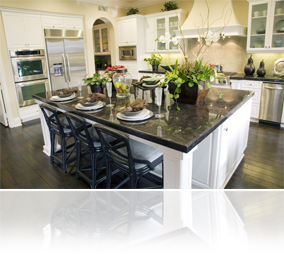Before Buying, Real Estate Pros Insist on Doing These 4 Things
What you really need to know about buying — from the people who house hunt for a living.
One house you’re looking at has the wraparound porch you’ve fantasized about, but it’s on a high-traffic street. The condo you like has a doorman in the lobby (you can order online now!), but it has no dedicated parking. What to choose?
It’s not every day that you buy a home and make decisions about the next three, five, or 10 years of your life. Since you can’t exactly take a home on a test drive, how do you decide? That got us to thinking about real estate pros. When they’ve seen practically everything on the market, how do they choose?
Four pros who’ve seen it all share their advice and their stories of hunting for just the right home.
Compromise for Your Priorities
Veteran real estate agent Nancy Farkas knew exactly what she wanted in her home: ranch style, three bedrooms, high ceilings. But you know what she bought? A two-story Colonial.
Huh?
For Farkas, an associate partner with Coldwell Banker Heritage REALTORS®, in Dayton, Ohio, the home’s location and price trumped style. “I had a dog I had to go home and walk at noon, and the house was close [to work] and the right price,” she says.
Her advice: Make sure your practical and functional priorities don’t get lost in all the home buying hoo-ha (sparkling granite counters, new hardwood floors, a steam shower!). Remember, you can always add the hoo-ha, but you can’t make a home fit all priorities, such as location and price.
Dig Into the Details (Dull, Yes, But Worth It!)
When Grigory Pekarsky, co-owner and managing broker with Vesta Preferred Real Estate in Chicago, was looking for his first home, one of his priorities was to minimize his maintenance costs. He made sure to find out if the house had a newer roof, good siding, and a newer furnace. But he recommends you go even deeper to uncover a home’s not-so-obvious maintenance costs:
- Scope out the sewer line — especially if you’re interested in an older home — to make sure there aren’t any tree branches or other debris clogging up the works. Otherwise, you might find some nasty sludge in the basement.
- Look at the trees. How mature are they? Roots from older trees can invade the sewer line; untrimmed branches can pummel your gutters during storms.
- Know what’s not covered by homeowners insurance. “I learned seepage isn’t covered. Shame on me,” he says.
- Ask how old the appliances are. You might need to budget for something new in a few years. Sellers are only required to fix what the inspector finds is broken; they’re not going to upgrade working appliances for you.
Seek a House That Matches Your Lifestyle
Having lived the high-rise apartment life as a renter, Pekarsky knew a single-family home was just what he wanted. He was tired of living in a relatively small space with no yard. He wanted a house he could “grow into in the next three to five years.” That meant multiple bedrooms and bathrooms for the family he plans on having. So what he bought — a three-story, single-family with a finished attic bedroom (shown below) on Chicago’s North Side — suits his lifestyle perfectly.
In addition, “you get the biggest value from owning the land,” he says. “In a single-family [home], people aren’t telling you what to do with the investment.”
On the other hand, Matt Difanis wished he’d bought a condo when he bought his first home, a small bungalow ranch in a charming, historic neighborhood in Champaign, Ill. It was first-home love — until it rained.
“If I didn’t clean out the gutters before every rainstorm, the basement would leak,” says the broker-owner of RE/MAX Realty Associates in Champaign. He didn’t realize that taking care of a single-family home wouldn’t be his cup of tea. “I should have opted for a condo without gutters to clean and a lawn to mow,” he says.
Agent Amy Smythe Harris of Urban Provision REALTORS®, in Woodland, Texas, bought a home with a sizable downstairs suite her parents could use now (and she could use years from now). She says her millennial clients aren’t forward-thinking about their lifestyles. Some are childless and say they don’t care about schools, pools, and tennis courts. Then they become parents a few years later and have to move.
“Once they have kids, the first question [they] ask is about school districts, and the second is about where the parks and pools are,” she says.
The pros’ bottom-line advice: Think of your lifestyle preferences and how those might change in the next few years. After all, the typical homeowner lives in a house for a median of 10 years before selling, NATIONAL ASSOCIATION OF REALTORS® data shows.
Look at the House Through the Lens of Resale
All the real estate pros we talked to — no surprise here — emphasized resale. Take appraiser Michelle C. Bradley of Czekalski Real Estate Inc. in Natrona Heights, Pa. When she built her current home — a 2,200-square-foot ranch — she included a full, unfinished basement, even though she has no use for one and rarely ventures into it.
Why would she do that? Because basements are standard in her southwest Pennsylvania market. But Bradley’s not going to finish the basement until she’s ready to sell. That way, she avoids having to clean it and ensures she’ll install the most fashionable bathroom fixtures at sell time.
Her advice: “Don’t buy or build something unique that you can’t resell. If you’re not in an area with log homes, don’t choose a log home. If you’re not in an area with dome homes, don’t choose a dome home.”
Likewise, If you buy a home priced higher than average for the area, it’ll be difficult to resell at a higher price.don’t buy a home that’s not in line with the neighborhood’s average price . When you go to resell, you’ll find yourself in an uphill battle to maintain your higher price.
Other advice from the pros: Watch out for unfixable flaws that could affect resale, like:
- What’s next to the home, such as vacant land that could be developed, high-traffic businesses, noisy power generation stations, a cell tower, etc.
- Lot issues, such as a steep driveway that could double as a ski slope in winter, or a sloped yard that sends water special delivery to your foundation.
Of course, a home isn’t just about resale. It’s just one factor to consider. Remember the first point: Be willing to compromise for your priorities. If the home meets your priorities and you’re going to stay there awhile, then resale might be where you compromise.
Related: Are You Making a House-Hunting Etiquette Mistake?
Christina Hoffmann also contributed to this story.




